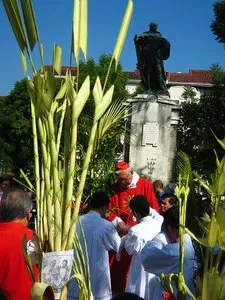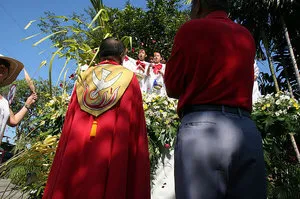Palaspas Lenten Passion
Faith and the Filipino Palm Leaf Art
by: Elmer Nocheseda
Palm Sunday in the Philippines is most dramatic. To commemorate the entry of Jesus Christ into Jerusalem, Filipino Catholics bring their palaspas or decorated palm fronds, to church to be blessed by the priests. It is always a sight to behold when young fresh coconut leaves called ibus are transformed into intricate forms and shapes. It is one great spectacle to see the brimming Sunday congregation eagerly wave their palaspas as the priest passes by to bless them.

Palaspas, which is the most intricate, provides an exciting opening act for the drama and passion of Semana Santa. The sight and smell of fresh palm fronds herald Holy Week in the Philippines. On the other hand, its burnt soot marked as a cross in the forehead on Ash Wednesday opens the forty days of Cuaresma or Lent.
More than this characteristic religiosity, the palaspas showcases the Filipino’s inherent artistry and creativity. His dexterity is amazing as to how he could transform the fresh fronds of niyog, silag, sasa, anahaw or buri palms into plaited and decorative patterns and empower them with religious meaning and values. His propensity for bright colors and profuse embellishment is put into maximum use as the palaspas is decorated with crepe paper flowers, estampitas, and banderitas.
The onsanahan, also called galilea or singkaban, is an elevated platform decorated with palm leaves and colored paper flowers and buntings. They are built around the church patio for the choir dressed as angles who will sing the Hosanna chants of the day.
Tuklong, kubol, sibi or puni, are the temporary sheds decorated with palaspas, and where they prepare altars for their saints as they sing the Pasyong Mahal on top of their voices.
Fray Juan de Plasencia, a Franciscan priest stationed in Nagcarlan noted in 1589 the penchant of the early Tagalogs to weave palm leaves to decorate their rituals. He noted that, “in the center of the house they place one large lamp, adorned with leaves of the white palm, wrought into many designs.” Fray Plasencia is obviously describing to us the palaspas.
Palaspas also acquire regional characteristic as well. The palaspas makers in the Tagalog Region create intricate palaspas that has basically two parts: a decorative handle and the decorated fronds.
The decorative handle may be heart-shaped or woven like a mat or folded into overlapping bows. On the other hand, the fronds are from which hang the woven stars, grasshoppers, and other figures from palm leaves or other tiny paper flags. The fronds are cut and woven to enhance various textures and designs. The fronds may be cut or folded or may be plaited to form zigzag patterns called kidlat (lighting ), espada (sword), bola (ball), ibon (bird), hipon (shrimp).

However, in the Ilocos region, this distinction is lost between handles and decorated fronds as the design becomes basically austere. They prefer the whitish leaflets of the silag fronds than the yellow green ones of the coconut. They also bunch sprigs of odiferous fennel, or anis, sprouts.
These distinct Ilocano designs were described by Don Isabelo de los Reyes in his El Folk-lore Filipino published in 1889. He noted that “the palm leaves are decorated with pajaritos (small birds), culebras (snakes), estrellas (stars), piñas (pineapples), and other figures.”
In the Vizayas, the kurus sa lukay, or palm leaf cross is the favorite motif and it acquires very intricate and pleasing flourishes. The austere but powerful symbol of the cross is combined with other folded shapes to create potent symbolism that they are often used to guard households from fire, tempest, and misfortunes. Combined with rituals, the kurus also protect the crops from pests, assure bountiful harvest, and protect the person from dili ingon nato, or those that are not like us.
Palaspas is created for specific functions and for specific occasions. And it lasts for as long as its purpose is being served. A great part of its beauty and function is in its freshness. Once dried, much is lost. Its beauty is indeed ephemeral. Its function, temporary. Like life itself, we enjoy it while it lasts.
The images of the palaspas expressed in the palm fronds reflect simple everyday objects, just like the material itself, which is a basic element in Philippine life. This is an art form generated by the people, with no single creator to claim credit for its beauty. Its simplicity as well as its inherent intricacy makes palaspas very attractive.


